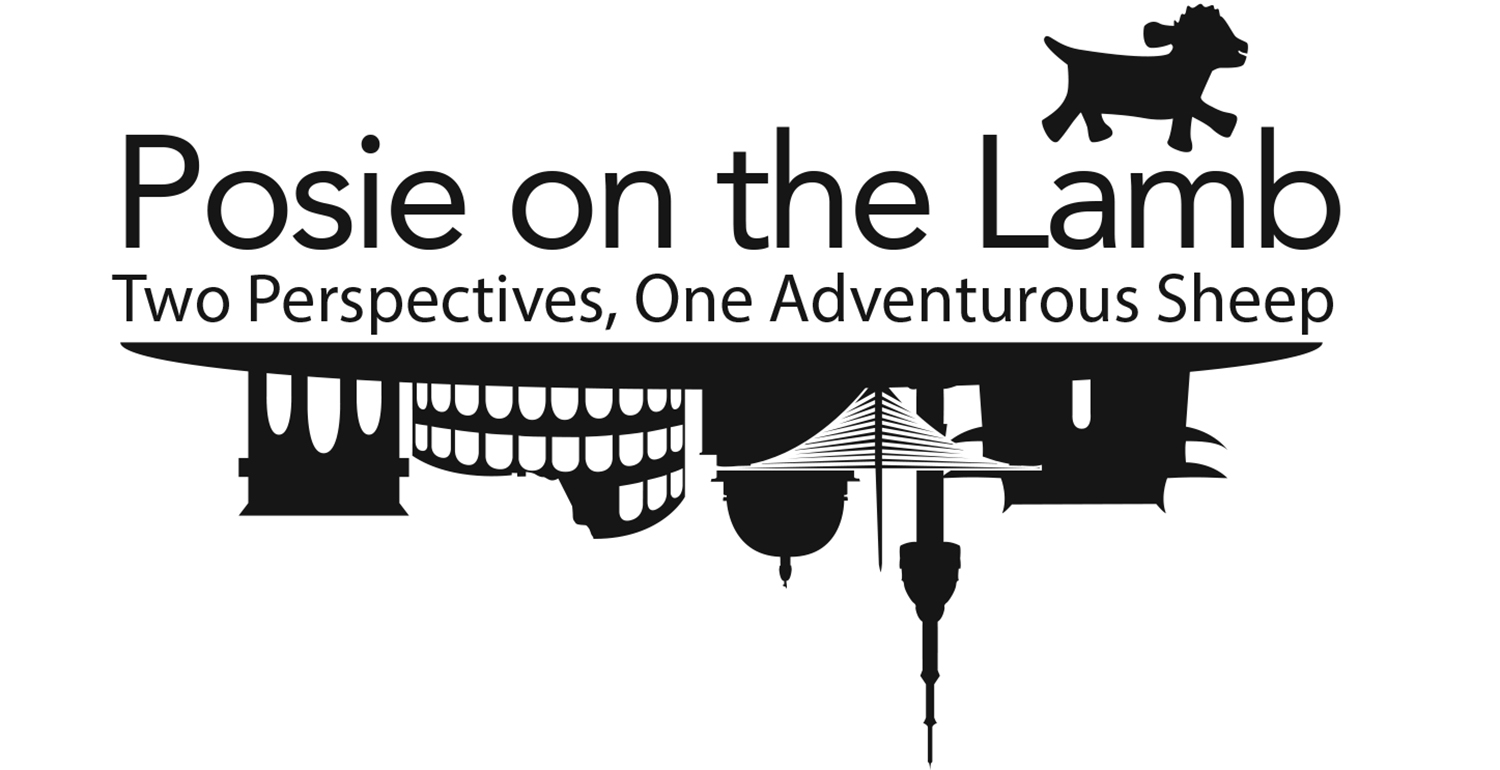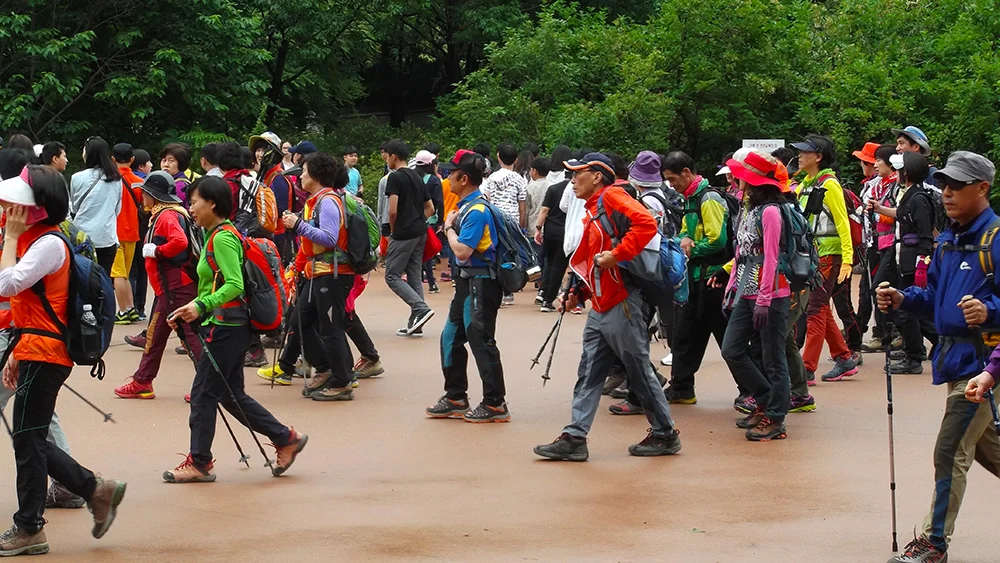Seoraksan National Park

“Sunblock?” “Check.”
“Bug spray?”
“Check.”
“Chocolate?”
“Oh, so much.”
Sam shouldered the backpack and clicked in the chest strap. “Let’s do this thing.”
It was a cool, cloudy Thursday. Thanks to election day falling close against a national holiday, we had a long weekend to fill. So we’d come to Gangwon-do, a northeastern province famous for its mountains. Our plan was to do a little hiking around Seoraksan National Park.
‘San’ is the Korean word for mountain, and the peaks of Seoraksan were nothing like the green folds that drape around Chungju. These were vertical slopes of weathered brown rock, the kind with views you really wouldn’t want to fall from. It was cool and misty when we got there. The bald, knobby peaks were lost in the cloud cover. We’d forgotten our rain jackets, but a little bad weather wasn't going to slow us down.
Or anyone else, for that matter. We stopped in the entrance to goggle at the river of technicolor nylon flowing into the park.
“I thought you said it wouldn’t be crowded today,” Sam said as a parade of preschoolers marched by. In their rain capes and yellow pants they looked like a row of ducks.
“It’s not supposed to be. The holiday isn’t until tomorrow.” I watched as another bus pulled up and a hiking club spilled out, middle aged women in sun visors and neon sneakers. Everyone looked like they’d raided an outfitter on their way to the park. In our t-shirts and jeans, I was starting to feel conspicuously under-dressed. Only in Korea.
We’re used to doing things with crowds these days. Going to the beach means renting an 8x8 square of sand, adjacent on three sides with other plots. Camping is apparently the same thing on asphalt. Public squares and parks are constantly full of badminton games, strollers, groups of men playing jokgu (a Korean game that combines soccer and volleyball), old women sitting on pavilions, kids trying out the public exercise equipment.
In a crowded society, everyone’s used to it. Even when it's so cramped your picnic blankets touch, your neighbors won't pay any attention to you. The general attitude is that we’re all outside together, so you do your thing and I’ll do mine and let’s just not bother each other, ok?
But hiking? Somehow we hadn’t put nature walks into this category.
So we stood in line to catch the famous cable car to a foggy peak, then walked single file along the path to the top.
Sam called it conga-hiking, and sang under his breath behind me. At the top, we took a bunch of pictures with the milky, empty backdrop of fog, then joined the line going back down.
Then we got some lunch.
And this was when we realized how different Korean national parks are from American ones. The American hiking experience doesn’t generally involve restaurants. There’s a parking lot, a pit toilet and a signboard trail map. That’s it for amenities. Hiking in the US is a quiet, hearty way for get away from it all. It works because the US is so endlessly huge—there’s more than enough land for solitude and wilderness.
Korea, on the other hand, is tightly packed. There are only so many places to go on vacation, and everyone ends up there together. So public facilities are designed to offer the greatest possible convenience to the greatest possible number of people. Every half mile on the trail, you’ll find a restaurant, a convenience store, maybe even a coffee shop. There are bathrooms at least as often (with a bonus rack of porta potties next to the flushers). If you look up into the trees, you'll see power cords threading through the branches.
Which is how we got to eat bibimbap in the middle of a forest. In fact, every time we entered a clearing, overeager shopkeepers tried to steer us inside with offers of ice cream, soup, soda, and tea. They pantomimed eating and drinking for the benefit of us foreigners. (Pro tip: the best way to avoid salespeople is to speak rapid Korean and dash away when they pause in shock.)
We spent hours tromping down trails, with the crowds thinning to almost nothing as we moved away from the main area. And still, we had no concept of just how big this park was. Until we actually checked the map, and realized we'd barely made a fraction of a dent.
It turns out that to see anything much in Seoraksan, you need to be prepared for a two or three-day journey, or at least a full day of pounding out miles. There are overnight shelters throughout the park for anybody trying to reach the most remote parts. Since we were lacking in just about everything—food, tents, even rain jackets—this was clearly not an option.
So we pushed to the first junction, watched a rocky waterfall from an arching metal bridge, and paused for a rest at a coffee shop. The hiking horde marched on, but we turned back and rejoined the families circling near the main entrance. After hours in the woods, we burst into sunshine at a crowded parking lot and limped toward the bus stop.
"Good day?" Sam asked as we boarded.
"Good day." I agreed. "Now let's go get some chicken."
-Erin
Getting to Seoraksan:
We’d put off Seoraksan for ages because it looked difficult to reach without a car. It turns out this is an easy trip. Take a bus to Sokcho, the nearest town. From the bus station, you can catch either the 7 or 7-1 city bus to Seoraksan. The park is the last stop. The ride only takes half an hour, and they run all day. Bus fare is 1,100 won per person.
We’d read that admission to the park is free. This is NOT true, but it’s still quite cheap: 3,500 won per person. The cable car is 9,000 won, though, and a meal at a park restaurant is about 8,000 won apiece.













